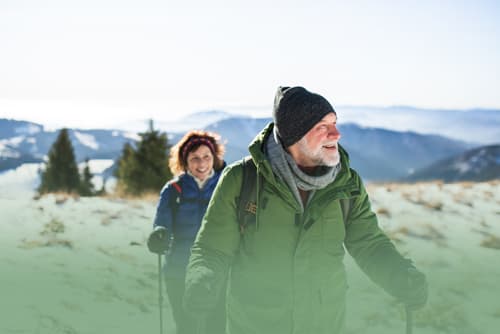If COVID-19 has taught us anything, it’s how crucial it is to live a healthy lifestyle. Some of that entails physical activity, which becomes a challenge for many during the cold, snowy, winter months. Just the thought of exercising in chilly temperatures can elicit a shiver.
Nicole Clements, certified athletic trainer for the Orthopedic Center of Excellence, offers tips for keeping up with your fitness routine despite the change of season. She also explains why exercising throughout the entire year is beneficial for more than just keeping your weight in check.
“If you're someone who wants to be active during warmer months, whether that's through outdoor activities like hiking, sports, or exercise, you want to exercise all throughout the year. You want to make sure you stay active during the winter months, because that will lower your risk of injuring yourself once you resume those activities. And, you'll also be able to get back into your activity more quickly,” she notes.
What to do When Indoor Workouts Aren't an Option
Exercising indoors is one option, if you have access. Many fitness facilities remain closed due to the pandemic. Others are limited to outdoor-only workouts. While there are plenty of at-home exercise programs available (some at no cost), not everyone enjoys working out inside.
“For me, I enjoy running but I really dislike running on a treadmill. I prefer running outside whenever possible. So, if that's not really your thing, there are still a number of activities you can do to remain active during the winter months,” states Clements.
She suggests contacting your local parks department for varying opportunities (indoors or outdoors). Naturally “social distanced” activities like downhill or cross-country skiing, snowshoeing, or even something as simple as sledding all get you outside and moving. If you don’t own necessary equipment, you can often rent it without breaking the bank.
“Here where I live in Pullman, the university rents skis, snowboards, snowshoes, and plenty of other equipment through their outdoor rec center for a really reasonable price,” adds Clements.
How Important are Warmups and Cool-Downs?
Research shows that prevention programs can help reduce injury for a number of reasons. They improve proprioception and strength, biomechanics, and also help train muscle memory patterns. Warming up your muscles prior to exercise prevents injuries by increasing the length to failure and elasticity of your muscles—meaning, how far they can be pushed before injury occurs.
The need to warm up varies depending on the individual, as well as what activity will be performed. “If you are just going for a vigorous walk or even a hike, warming up isn't as big of a deal as if you are going to go run a marathon or do something that's a lot more rigorous,” shares Clements.
Typically, dynamic warmups—moving the body using progressive movements to stretch and warm up different muscles and parts of your body—seem to be more effective than static stretching, where you're standing or sitting in one spot and stretching one muscle or body part.
As far as cooling down goes, Clements says there’s no solid evidence that doing so prevents injuries. From a cardiovascular perspective, warmup and cool-down periods are important. “They get you into and take you out of that workout phase, so you're not putting a lot of stress all at once on your body.”
Choosing Proper Clothing and Footwear
Proper attire may actually be the most important factor in ensuring safe outdoor exercise. The Norwegians actually have a saying: "There's no such thing as bad weather, only bad clothes."
Clements advises layering, ensuring the clothing closest to your body is lightweight and breathable. Wool is a good option, as is a blend of fabrics like nylon or spandex—anything that will help wick moisture away from the body instead of trapping it on your body. She also cautions against cotton fabrics.
And, don’t forget the shoes! Make sure you're wearing proper shoes in general, not just during the winter months. They should fit well, have good arch support, and have traction for icy conditions. “You can also add on traction cleats, like Yaktrax for example, to give you a better grip on the ice if you're wanting to run or exercise outside,” suggests Clements.
If you do find yourself falling due to the conditions, it’s best to tumble “right.” Falling on an outstretched arm is a common mechanism of injury, and it frequently leads to sprains or fractures. “So, direct your fall onto your butt or your side,” explains Clements.
Listen to Your Body
Whichever activity you participate in during any season, Clements urges a mindful approach.
“Listen to your body. I think the majority of people I know, and I certainly feel this way, tend to feel better about themselves and their body when they're active more frequently. But, you also need to make sure you're listening to your body when it's telling you you’re pushing yourself too hard and you need to take a rest.”

